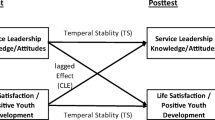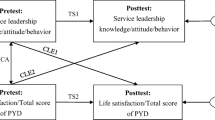Abstract
This study examined how college experiences affect student leadership capacity in the general college population, as well as in male versus female populations. The data were drawn from a longitudinal sample of students across 156 colleges in Taiwan. Results of this study indicated that student leadership capacity increased after college entry. After controlling for pre-college experiences and structural characteristics, various college experiences of curricular learning, cocurricular learning, and interpersonal interaction persisted as significant factors affecting student leadership capacity across genders. College experiences of class skipping and campus residence demonstrated different effects than those found in the Western literature. Comparative results of male and female students in various contexts detected using a statistical method and criteria demonstrated that, in the case of Taiwanese college students, both genders were similarly affected by their college experiences as far as leadership capacity is concerned.
Similar content being viewed by others
References
Antonio, A. L. (2001). The role of interracial interaction in the development of leadership skills and cultural knowledge and understanding. Research in Higher Education, 42, 593–617.
Astin, A. W. (1977). Four critical years. San Francisco: Jossey–Bass.
Astin, A. W. (1991). Assessment for excellence: The philosophy and practice of assessment and evaluation in higher education. New York: Macmillan Publishing Company.
Astin, A. W. (1993a). An empirical typology of college students. Journal of College Student Development, 34, 37–46.
Astin, A. W. (1993b). What matters in college? Four critical years revisited. San Francisco: Jossey–Bass.
Astin, A. W. (1999). Student involvement: A developmental theory for higher education. Journal of College Student Development, 40(5), 518–529.
Astin, A. W. (2003). Studying how college affects students: A personal history of the CIRP. About Campus, 8(3), 21–28.
Astin, A. W., & Denson, N. (2009). Multi-campus studies of college impact: Which statistic method is appropriate? Research in Higher Education, 50, 354–367.
Avolio, B., et al. (2005). Executive summary: 100 year review of leadership intervention research: Briefings report 2004–01, Gallup Leadership Institute. Kravis Leadership Institute, Leadership Review, 5, 7–13.
Baird, L. L. (1990). The undergraduate experience: Commonalities and differences. Research in Higher Education, 37(3), 271–278.
Balón, D. G. (2005). Asian Pacific American college students on leadership: Culturally marginalized from the leader role? NASPA’s NetResultS. Retrieved December 28, 2010, from http://daniello.balon-home.net/Balon_APAs_Leadership.pdf.
Bandura, A. (1997). Self-efficacy: The exercise of control. New York: W.H. Freeman.
Baxter-Magolda, M. B. (1992). Knowing and reasoning in college: Gender-related patterns in students’ intellectual development. San Francisco: Jossey–Bass.
Boatwright, K. J., & Egidio, R. K. (2003). Psychological predictors of college women’s leadership aspirations. Journal of College Student Development, 44(5), 653–669.
Bryant, A. N. (2003). Changes in attitudes toward women’s roles: Predicting gender-role traditionalism among college students. Sex Roles, 48, 131–142.
Carini, R. M., Kuh, G. D., & Klein, S. P. (2006). Student engagement and student learning: Testing the linkage. Research in Higher Education, 47(1), 1–32.
Cohen, J. (1988). Statistical power analysis for the behavioral sciences (2nd ed.). Hillsdale, NJ: Lawrence Earlbaum.
Couper, M. P. (2000). Web surveys: A review of issues and approaches. Public Opinion Quarterly, 64, 464–494.
Dobbins, G. H., & Platz, S. J. (1986). Sex differences in leadership: How real are they? Academy of Management Review, 11, 118–127.
Dugan, J. P. (2006a). Explorations using the social change model: Leadership development among college men and women. Journal of College Student Development, 47(2), 217–225.
Dugan, J. P. (2006b). Involvement and leadership: A descriptive analysis of socially responsible leadership. Journal of College Student Development, 47(3), 335–343.
Dugan, J. P., & Komives, S. R. (2010). Influences on college students’ capacities for socially responsible leadership. Journal of College Student Development, 51, 525–549.
Dugan, J. P., Komives, S. R., & Segar, T. C. (2008). College student capacity for socially responsible leadership: Understanding norms and influences of race, gender, and sexual orientation. NASPA Journal, 45(4), 475–500.
Dunkel, N., Bray, K., & Wofford, A. (1989). Training and raising awareness in career knowledge. Gainesville: Division of Housing, University of Florida.
Eagly, A. H., & Carli, L. L. (2007). Through the labyrinth: The truth about how women become leaders. Boston, MA: Harvard Business School Press.
Eagly, A. H., Karau, S. J., & Makhijani, M. G. (1995). Gender and the effectiveness of leaders: A meta-analysis. Psychological Bulletin, 117(1), 125–145.
Eagly, A. H., Makhijani, M. G., & Klonsky, B. G. (1992). Gender and the evaluation of leaders: A meta-analysis. Psychological Bulletin, 111(1), 3–22.
Elliott, S. (2003). Academic enablers and the development of academic competent students. In B. Bartlett, F. Bryer, & D. Roebuck (Eds.), Re-imagining practice–researching change (Vol. 1, pp. 38–60). Brisbane: Griffith University.
Feldman, K. A., & Newcomb, T. M. (1969). The impact of college on students. San Francisco: Jossey-Bass.
Furr, S. R., & Elling, T. W. (2000). The influence of work on college student development. NASPA Journal, 37(2), 454–470.
Gardner, J. (1996). Conclusion. In R. Kincaid (Ed.), Student employment: Linking college and the workplace (pp. 131–136). Columbia, SC: National Resource Center for The Freshman Year Experience and Students in Transition.
Gonyea, R. M. (2005). Self-reported data in institutional research: Review and recommendations. In P. D. Umbach (Ed.), Survey research emerging issues: New directions for institutional research (pp. 73–89). San Francisco: Jossey-Bass.
Hair, J. F., Anderson, R. E., Tatham, R. L., & Black, W. C. (2009). Multivariate data analysis (6th ed.). New York: Prentice Hall.
Hardy, M. A. (1993). Regression with dummy variables. Newbury Park, CA: Sage.
Hay, I., & Dempster, N. (2004). Student leadership development through general classroom activities. In B. Bartlett (Ed.), Educating: Weaving research into practice (pp. 141–150), Surfers Paradise, QLD, Australia.
Hoyt, C. L. (2005). The role of leadership efficacy and stereotype activation in women’s identification with leadership. Journal of Leadership and Organizational Studies, 11(4), 2–14.
Hu, S., & Kuh, G. D. (2003). Diversity experiences and college student learning and personal development. Journal of College Student Development, 44(3), 320–334.
Huang, Y., & Chang, S. M. (2004). Academic and cocurricular involvement: Their relationship and the best combinations for student growth. Journal of College Student Development, 45(4), 391–406.
Hwang, K. K. (2001). The deep structure of Confucianism: A social psychological approach. Asian Philosophy, 11(3), 179–204.
Hyde, J. S. (2005). The gender similarities hypothesis. American Psychologist, 60, 581–592.
Jang, S., & Kim, N. (2004). Transition from high school to higher education and work in Korea, from the competency-based education perspective. International Journal of Educational Development, 24(6), 691–703.
Karnes, F. A., & Bean, S. M. (1999). Lead the way to leadership education. Education Digest, 64, 62–65.
Kezar, A., & Moriarty, D. (2000). Expanding our understanding of student leadership development: A study exploring gender and ethnic identity. Journal of College Student Development, 41(1), 55–69.
Komives, S. R., Longerbeam, S. D., Mainella, F., Osteen, L., Owen, J. E., & Wagner, W. (2009). Leadership identity development: Challenges in applying a developmental model. Journal of Leadership Education, 8(1), 11–47.
Komives, S. R., Owen, J. E., Longerbeam, S. D., Mainella, F. C., & Osteen, L. (2005). Developing a leadership identity: A grounded theory. Journal of College Student Development, 46(6), 593–611.
Kuh, G. D., Kinzie, J., Buckley, J. A., Bridges, B. K., & Hayek, J. C. (2006). What matters to student success: A review of the literature. Commissioned Report for the National Symposium on Postsecondary Student Success: Spearheading a dialog on student success. National Postsecondary Education Cooperative. Retrieved December 25, 2010, from http://nces.ed.gov/npec/pdf/Kuh_Team_Report.pdf.
Lee, J. W., Jones, P. S., Mineyama, Y., & Zhang, X. E. (2002). Cultural differences in responses to a Likert scale. Research in Nursing and Health, 25, 295–306.
MacKinnon-Slaney, F. (1993). Theory to practice in cocurricular activities: A new model for student involvement. College Student Affairs Journal, 12(2), 35–40.
Maurer, T. J. (2001). Career-relevant learning and development, worker age, and beliefs about self-efficacy for development. Journal of Management, 27, 123–140.
McCormick, M. J., Tanguma, J., & López-Forment, A. S. (2002). Extending self-efficacy theory to leadership: A review and empirical test. Journal of Leadership Education, 1, 1–15.
Ministry of Education in Taiwan. (2009). Post-secondary schools summary table: 1998–2008 academic year. Retrieved May 13, 2010, from http://www.edu.tw/statistics/content.aspx?site_content_sn=8869 [in Chinese].
Multi-Institutional Study of Leadership. (2010). Study description. Retrieved December 26, 2010, from http://www.leadershipstudy.net/ir-study-description.html.
Owen, J. E., & Komives, S. R. (2007). Does credit matter? Examining the effects of curricular leadership programs. Concepts & Connections, 15(3), 4–6.
Pascarella, E. T. (2001). Using student self-reported gains to estimate college impact: A cautionary tale. Journal of College Student Development, 42, 488–492.
Pascarella, E. T., & Terenzini, P. T. (1991). How college affects students: Findings and Insights from twenty years of research. San Francisco: Jossey-Bass.
Pascarella, E. T., & Terenzini, P. T. (2005). How college affects students: A third decade of research. San Francisco: Jossey-Bass.
Pike, G. R. (1995). The relationship between self reports of college experiences and achievement test scores. Research in Higher Education, 36, 1–21.
Pike, G. R., Kuh, G. D., & Gonyea, R. M. (2003). The relationship between institutional mission and students’ involvement and educational outcomes. Research in Higher Education, 44(2), 241–261.
Pike, G. R., Kuh, G. D., & Massa-Mckinley, R. (2008). First-year students’ employment engagement, and academic achievement: Untangling the relationship between work and grades. NASPA Journal, 45(4), 560–582.
Powell, G. N. (1990). One more time: Do male and female managers differ? Academy of Management Executive, 12, 731–743.
Sax, L. J., Bryant, A. N., & Haper, C. E. (2005). The differential effects of student-faculty interaction on college outcomes for women and men. Journal of College Student Development, 46(6), 642–659.
Sean, T., Hannah, S. T., Avolio, B. J., Luthans, F., & Harms, P. D. (2008). Leadership efficacy: Review and future directions. The Leadership Quarterly, 19, 669–692.
Shertzer, J. E., & Schuh, J. H. (2004). College student perceptions of leadership: Empowering and constraining beliefs. NASPA Journal, 42(1), 111–131.
Shieh, H. P., Gong, Y. W., & Huang, S. Z. (1992). An investigation on the current status of cocurricular involvement among college students. Research in Moral Education, 319(3), 39–56. (in Chinese).
Smart, J. C., Ethington, C. A., Riggs, R. O., & Thompson, M. D. (2002). Influences of institutional expenditure patterns on the development of students’ leadership competencies. Research in Higher Education, 43, 115–132.
Tabachnick, B. G., & Fidell, L. S. (2007). Using multivariate statistics (5th ed.). Boston: Pearson.
Thompson, M. D. (2006). Student leadership progress development: An assessment of contributing college resources. Journal of College Student Development, 47(3), 343–350.
Titus, M. A. (2004). An examination of the influence of institutional context on student persistence at 4-year colleges and universities: A multi-level approach. Research in Higher Education, 45(7), 673–699.
Zhang, L. (2005). Do measures of college quality matter? The effect of college quality on graduates’ earnings. The Review of Higher Education, 28(4), 571–596.
Acknowledgments
The author is indebted to two anonymous reviewers for their insightful and valuable comments.
Author information
Authors and Affiliations
Corresponding author
Rights and permissions
About this article
Cite this article
Wu, CL. Effects of college experiences on male and female student leadership capacity in Taiwan. Asia Pacific Educ. Rev. 12, 641–652 (2011). https://doi.org/10.1007/s12564-011-9162-0
Received:
Revised:
Accepted:
Published:
Issue Date:
DOI: https://doi.org/10.1007/s12564-011-9162-0




